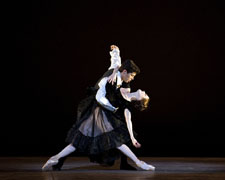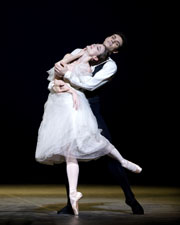
Jack Anderson
Ballet Theatre's Summer Obsession
American Ballet Theatre
John Neumeier: "Lady of the Camellias"
In repertory through July 10, 2010
Metropolitan Opera House, Lincoln Center
Mondays and Tuesdays at 7:30 p.m., Wednesdays at 2 and7:30 p.m., Thursdays
at 7:30 p.m., Fridays at 8 p.m., Saturdays at 2 and 8m p.m., $20-$111
Tickets: (212) 362-2000 or www.abt.org
When summer arrives, American Ballet Theatre moves into the Metropolitan Opera
House with a splendid array of dancers and a strange monomania. The company
becomes obsessed with evening-long ballets, as if Kevin McKenzie, its artistic
director, and his staff believed that Met programs must focus on fancy multiact
blockbusters; otherwise, audiences might not come or, if they did, they would
be underwhelmed. This idea is a foolish one that flies against both the company's
own history and that of contemporary ballet in general.
 |
| Julie Kent
and Roberto Bolle in "Lady of the Camellias." Photo by Gene Schiavone. |
Although spectacles can appear genuinely spectacular in theaters of opera-house dimensions, shorter small-scale works can also be effective there, as the company often demonstrated before its current fixation. In Ballet Theatre seasons long past, both at the Lincoln Center theaters and at the old Met, what mattered was not the size of a production, but its quality. Therefore more attention was given to shorter pieces because most of the great ballets created since the beginning of the 20th century have been in one act.
Theoretically, there is nothing inherently wrong with full-evening works. There just aren't enough good ones. Of course, we have the 19th-century classics. But, and let's face the melancholy fact, not many have survived from the past and, compared with the richness of the dramatic and operatic repertories, comparatively few are first-rate. And ABT's production record for totally new multiact creations tends to be depressing.
Yet ABT continues trying, and it tried again this summer with John Neumeier's "Lady of the Camellias," a ballet in a prologue and three acts lasting about two hours and fifteen minutes, inspired by the Alexandre Dumas fils novel that also inspired "La Traviata," the Garbo "Camille," and previous ballet versions by John Taras, Ruth Page, Antony Tudor, and Frederick Ashton, among others. It's not hard to understand the story's choreographic appeal: its events are clear, and in Ashton's "Marguerite and Armand" they move so swiftly that the ballet becomes a schematic reduction of the tale to its bare bones.
Neumeier takes a more leisurely, reflective approach to the material, which accounts for both his ballet's distinctiveness and for some of its problems. When ABT announced its intention to stage it, balletomanes with long memories must have scratched their heads in puzzlement. "Lady" has been seen here before, without much success. Created for the Stuttgart Ballet in 1978, it was brought to New York a year later, when many critics and balletgoers greeted it with yawns. I was among the yawners then, for it struck me as tedious stuff. But Neumeier revised the ballet in 1981, and this revised version has now reached ABT. I still find parts of it tedious, but not as much so as I did then. Although I remember almost nothing about the first version's choreographic details, Neumeier's revisions may well be improvements or, possibly, I have gotten used to Neumeier's pacing. Nevertheless, for me, "Lady of the Camellias," despite some felicitous moments, still fails to be dramatically compelling.
Now as then, Neumeier has crowded it with too much stuff, his worst mistake being to combine the story of Marguerite Gautier with that of the characters in a ballet version of "Manon Lescaut" that Marguerite sees on a visit to the theater. These characters frequently return to haunt her imagination. Such parallelisms do occur in the Dumas novel. But what may be thought-provoking on the printed page can look over-complicated on the stage. Two unhappy courtesans may be one too many: focus is blurred. And Neumeier makes Marguerite and Armand far more interesting choreographically than Manon and Des Grieux, even as danced by such fine artists as Gillian Murphy and David Hallberg who, for reasons unknown, has been given some unpleasantly spectral makeup.
But Neumeier's fondness for superfluous details is also related to one of his greatest strengths: his love of particularities. Each scene has an atmosphere of its own; each person on stage has a distinct personality and specific things to do. Like a composer paying attention to silences as well as sounds, Neumeier makes pauses and facial expressions vital parts of his choreography. His crowd scenes are more than milling about, and his secondary roles can be as rewarding as the starring parts: consider, for instance, the stony rectitude of Roman Zhurbin as Armand's father or the fussy bustle of Julio Bragado-Young as the inane, yet curiously sympathetic, Count N.
 |
| Julie Kent
and Roberto Bolle in "Lady of the Camellias." Photo by Gene Schiavone. |
As for the leading couple, Julie Kent (Marguerite) and Roberto Bolle (Armand) danced Neumeier's choreography to the hilt, yet let the virtue of restraint prevent them from lapsing into kinetic hysteria. Neumeier has devised some stormy pas de deux of a sort now fashionable, with lots of twists, fancy acrobatics, and high lifts. But Kent and Bolle never tore Neumeier's choreographic passions to tatters.
As a dance maker, Neumeier can be inventive, yet in "Lady of the Camellias" he usually refrains from overdoing effects. Thus, although he chose compositions by Chopin as accompaniment, the orchestra was heard only in those pieces Chopin intended for orchestra; the rest were presented in their original piano versions, rather than in some possibly bloated orchestration. Yet if Neumeier recognizes the virtue of restraint, he can also be longwinded. And because he was so here, I wondered why Ballet Theatre considered "Lady of the Camellias" a suitable addition to the repertory. Although Neumeier is an American, this German-based choreographer, much admired in Europe, has had bad luck in his native land. Audiences here have yet to take to him. Nevertheless, I can think of several Neumeier ballets I would like to see again: for example, his Mahler symphonies (especially the stirring Third), his Bach "St. Matthew Passion," and his adaptations of Mann's "Death in Venice" and H .C. Andersen's "Little Mermaid." But many of those works require large orchestras and sometimes vocalists, as well, making them impractical for most American ballet companies, although not for troupes attached to the European opera houses in which Neumeier is most at home.
American Ballet Theatre continues searching for some magical full-evening ballet that will set summer audiences swooning, critics raving, and box-office coffers ringing. With luck, it may find one. But its quest might well turn out to be artistically fruitless and monstrously costly. Perhaps the company should overcome its summertime obsession with scale and concentrate on excellence instead in ballets of any and every size.
| museums | NYTW mail | recordings | coupons | publications | classified |
